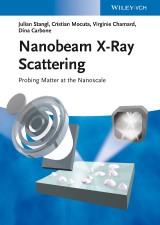Details

Nanobeam X-Ray Scattering
Probing Matter at the Nanoscale1. Aufl.
|
99,99 € |
|
| Verlag: | Wiley-VCH |
| Format: | |
| Veröffentl.: | 11.09.2013 |
| ISBN/EAN: | 9783527655090 |
| Sprache: | englisch |
| Anzahl Seiten: | 284 |
DRM-geschütztes eBook, Sie benötigen z.B. Adobe Digital Editions und eine Adobe ID zum Lesen.
Beschreibungen
A comprehensive overview of the possibilities and potential of X-ray scattering using nanofocused beams for probing matter at the nanoscale, including guidance on the design of nanobeam experiments. The monograph discusses various sources, including free electron lasers, synchrotron radiation and other portable and non-portable X-ray sources.<br> For scientists using synchrotron radiation or students and scientists with a background in X-ray scattering methods in general.<br>
INTRODUCTION<br> X-RAY DIFFRACTION PRINCIPLES<br> -Introduction<br> -Beam Coherence<br> -Specific Properties of Different Sources: Laboratory vs <br> Synchrotron vs FEL<br> FOCUSING OF X-RAYS<br> -Beam Propagation and Modeling<br> -Focusing Principles Available for the Hard X-Ray Regime<br> -Clasic Microfocusing Devices<br> -Practical Issues<br> SCATTERING EXPERIMENTS USING NANOBEAMS<br> -From the Ensemble Average Approach Towards the Single <br> Nanostructure Study<br> -Diffraction from Single Nanostructures<br> -Scanning X-Ray Diffraction Microscopy<br> -Other Types of Contrast<br> -Local X-Ray Probe Experiments from Organic Samples<br> -Local X-Ray Probe Experiments from Biological Samples<br> NANOBEAM DIFFRACTION SETUPS<br> -Beam Positioning on the Nanoscale<br> -Stability Issues: Maintaining the Spot on the Sample <br> During Scanning Angles, Vibrations<br> -Active Systems to Maintain the Beam Position on the <br> Sample Constant<br> -Restriction of Different Setups<br> -Detector Issues: Resolution in Real and Reciprocal <br> Space, Dynamic Range, Time Resolution<br> SPECTROSCOPIC TECHNIQUES USING FOCUSED BEAMS<br> -Micro/Nano-EXAFS, XANES. Fluorescence<br> -A Side Glance on Soft X-Ray Applications<br> COHERENT DIFFRACTION<br> -More on Coherence Properties of Focused X-Ray Beams<br> -The Use of Phase Retrieval Instead of Modeling <br> Approaches<br> -Different Retrieval Algorithms<br> -Shape Determination of Single Structures (Retrieving <br> the Modulus of Electron Density)<br> -Strain Determination (Retrieving the Phase of Electron <br> Density)<br> -Fresnel Coherent Diffractive Imaging<br> -Holographic Approaches (Using a Reference Wave Instead <br> of Numerical Phase Retrieval)<br> -Ptychography (For Extended Objects with Nanoscale <br> Structure)<br> -Particular Advantages and Problems when Using Coherent <br> Diffraction Imaging in the Bragg Case<br> THE POTENTIAL AND THE LIMITS OF THE METHOD<br> -Limits in Beam Size <br> -Limits in Intensity/Brilliance<br> -Resolution Limits in Real and Reciprocal Space<br> -Combinations with Other Local Probe Techniques <br> FUTURE DEVELOPMENTS<br> -Detector Developments<br> -Beamlines at Third Generation Synchrotron Sources<br> -The Role of Free Electron Lasers<br>
Julian Stangl is working on the investigation of semiconductor nanostructures using x-ray scattering at Johannes Kepler University in Linz, Austria, where he also obtained his academic degrees. He has performed numerous experiments at synchrotron sources throughout Europe, and is developing nanobeam diffraction in collaboration with the European Synchrotron radiation facility in Grenoble, France. His received several scientific awards, including the Erich Schmid price of the Austrian Academy of Sciences.<br> <br> Cristian Mocuta is presently working at the French Synchrotron Facility, the 'Synchrotron SOLEIL' and is in charge of the microbeam approaches and their development, for diffraction (?XRD) but also complementary analysis by fluorescence and absorption spectrosopies (?-XRF and/or ?-XAS). His scientific interest resides in the study of the properties of materials at local scale (?m and below) using mostly x-ray diffraction technique. He obtained his academic degrees at the Joseph Fourier University in Grenoble, France, then joined as a scientist the European Synchrotron Radiation Facility (ESRF) where he was involved in the development of a micro- / nano-diffraction setup.<br> <br> Virginie Chamard is working on methodological developments of lens-less microscopy techniques at the Fresnel Institute in Marseille (France). Her concern is the imaging of nanocrystal structural properties at the local scale based on the inversion of intensity patterns obtained with coherent x-ray beams. After her academic degrees at the Grenoble University, she had some experiences at the European Synchrotron Radiation Facility and in Germany. Her CNRS position allowed her to successively work with different groups in France, in Grenoble and Marseille and to develop collaborations in the field of coherent x-ray scattering. <br> <br> Dina Carbone is currently working on the investigation of nanostructures using X-ray scattering techniques. After obtaining her degree at the Max-Plank-Institute for Metal-Research and the University of Stuttgart, Germany, she has started to work at the European Synchrotron Radiation Facility in Grenoble, France, where she is now contributing, as beamline scientist, to the development of nano-beam methods and their application in material science. <br>
<p>A comprehensive overview of X-ray scattering using nano-focused beams for probing matter at the<br /> nanoscale is presented. The monograph includes guidance on the design of nano-beam experiments<br /> and discusses various sources, including free electron lasers, synchrotron radiation and special laboratory<br /> sources.</p> <p>The rapid progress of this research area was initiated by the availability of brilliant well-collimated<br /> synchrotron X-ray sources and is strongly linked to the recent development of state-of-the art devices<br /> now capable to focus hard X-rays. Accordingly, several experimental methods have developed, such as<br /> nano-beam based scanning diffraction microscopy and spectroscopy, coherent diffraction imaging, etc.<br /> They are used in a broad range of applications in material science, from semiconductor nanostructures<br /> to biological specimen.</p> <p>It therefore seems a good time to give a first résumé on the achievements made, an overview on<br /> techniques and applications currently available, and based on that, an outlook on the potential of this<br /> approach.<br /> <br /> From the contents:<br /> <br /> • X-ray diffraction principles<br /> <br /> • X-ray focusing elements characterization<br /> <br /> • Nanobeam diffraction<br /> <br /> • Nanobeam diffraction setups<br /> <br /> • Spectroscopic techniques using focused beams<br /> <br /> • Coherent diffraction<br /> <br /> • Coherent limits<br /> <br /> • Future developments</p>
Diese Produkte könnten Sie auch interessieren:

Scaling Issues and Design of MEMS

von: Salvatore Baglio, Salvatore Castorina, Nicolo Savalli

110,99 €















